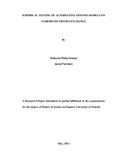| dc.description.abstract | This study presents a new pricing approach and examines the volatility index by using
GARCH-type approximation relation on a security in a local capital market. The
originality of this approach is to model the local volatility of the securities to obtain
accurate approximations with tight estimates of the error terms. This approach can also be
used in the case of pricing options with stochastic convenience yields. The model is
applied to Nairobi Securities Exchange (NSE) All Share Index Stock data. From the real
market data, the realized volatility is empirically analysed by measuring the deviations of
pricing errors. Because of its analytical tractability, the implied parameters are estimated
from minimizing the weighted sum of squared errors between the market data.
The study combines the computational knowledge and option pricing theory, to
investigate, design and implement a new option pricing approach, by empirically testing
the alternative GARCH pricing model, which can process the observed volatilities or
market returns to price the equities. The approach could help researchers to test the
accuracy of the pricing model or their input volatility, and also can help investor to
compare the market with the estimated price to discover the best investment moment. The
discussion, methodology and testing are focused on the issues of computational finance.
The findings in this study have evidenced that positive correlation between stock index
returns and volatility has two implications. When the stock index return is high, volatility
tends to be high. Conversely, when the stock index return is low, volatility tends to be
low. The approach of this study can be used to adjust volatility index levels by measuring
deviations of pricing errors of future share prices before expiration of each trading period | en |

